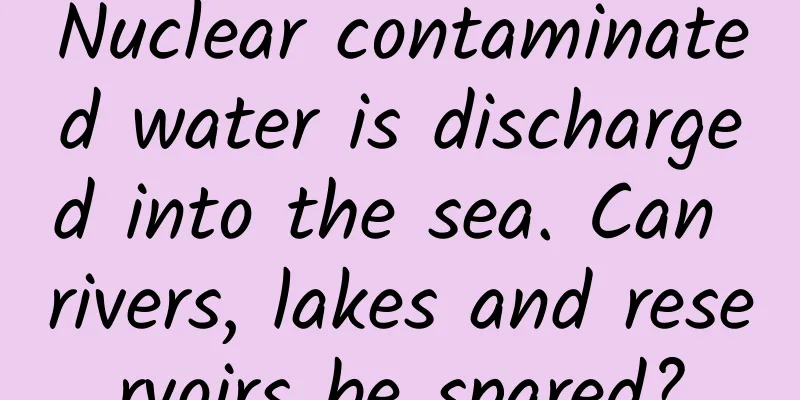Nuclear contaminated water is discharged into the sea. Can rivers, lakes and reservoirs be spared?

|
recent, There have been many discussions recently about "Japan's nuclear contaminated water discharge into the sea". But when it comes to ocean pollution , We have to talk about rivers and lakes . After all, they all originate from "water". Let’s talk about it today: In this process, the water molecule (H20) changes only from liquid to gas. Its molecular size and structure have not changed. Then in this process, What role do radioactive elements in nuclear contaminated water play? Their chemical formulas are: 1H (Protium, H) 2H (deuterium, D) 3H (Tritium, T) The nucleus of protium 1H has only one proton and is a stable isotope; The nucleus of deuterium 2H consists of 1 proton and 1 neutron, and it is also a stable isotope; The nucleus of tritium 3H is composed of 1 proton and 2 neutrons. It is a radioactive isotope, also known as " super tritium ". Although it has a large mass, it is not stable enough and easily loses neutrons to release energy, which is also the source of its radioactivity. As hydrogen's brother, tritium has similar properties to hydrogen and can easily replace H in water molecules (H20) through isotope exchange, turning into tritiated water (T2O), which enters the sea-land water cycle along with other water molecules. Based on relevant experts' predictions on the time it takes for nuclear contaminated water to flow into other sea areas and the half-life of various radioactive elements, can rivers, lakes and reservoirs avoid "nuclear" pollution? However, the half-life of tritium - the time it takes for the radiation to be halved - is 12.3 years. It is impossible for it to completely eliminate the radioactivity on its own, and the impact of nuclear pollution on rivers, lakes and reservoirs is inevitable. Considering only the effects of tritium , the possible good news is: The biological half-life of tritium (i.e. the half-life of the substance after entering the body) is 7 to 14 days. Similarly, tritium water can also be excreted from the body through sweating, urination, etc. However, tritium is only one of the more than 60 radioactive nuclides contained in nuclear contaminated water, and the harm it brings is just the tip of the iceberg of nuclear contaminated water discharged into the sea. The discharge of nuclear contaminated water into the sea in small quantities and batches may not seem to be enough to pose a direct threat to life, but it is only a matter of time before the "water vapor" from the Pacific Ocean lands in any corner of the world. Produced by Guangdong Science and Technology Newspaper Media Center Editor | Zhuo Yingzi Design | Zhuoyingzi Review | Liu Xiaoyong Feng Haibo |
<<: AI beats human champion again! This time, in drone racing
>>: Pregnant women can't eat crabs? This kind of crab can be eaten in moderation →
Recommend
An island floated after a volcanic eruption. Was it actually rocks floating on the water?
Recently, the Philippine Institute of Volcanology...
WeChat iOS 8.0.7 official version update: new creator center, video account fine-tuning
[[403991]] On June 7, Apple's iOS WeChat has ...
#千万IP创科学普# Why do people in southern Fujian like to say "only hard work can lead to success"?
When you lose your will, you can't help but c...
WeChat uses soft pornography to promote its video account. Does this mean that Tencent has no cards to play in the short video field?
Last week, WeChat Video Account was once again tr...
What will happen to the Qinghai-Tibet Plateau if global warming rises by 2°C?
If the global temperature rises by 2°C, what will...
The underlying logic of community fission and private domain traffic
As the clock struck 24:00 on Double 11 Carnival N...
This brain-burning thought experiment challenges quantum mechanics
As the most famous cultural symbol of quantum mec...
How QQ and WeChat platforms create aggregators of users’ scattered information!
There is no doubt that WeChat and QQ have become ...
Is it expensive to customize the Wuhu food ordering app? Wuhu ordering app customization cost and process
More and more businesses are paying attention to ...
How can medical accounts use OCPC to reduce consultation costs by 30%?
Friends who are familiar with Baidu ocpc know tha...
Driver killed elderly cyclist after looking down at phone 39 times in 7 minutes
On October 24, a bus driver took passengers from ...
Android background killing series 2: ActivityManagerService and App on-site recovery mechanism
This is the second in the Android background kill...
How much does it cost to be an agent of Wuxi Home Improvement Mini Program? What is the price of being an agent for Wuxi home improvement mini program?
Why should you be an agent for WeChat Mini Progra...
How to optimize advertising creatives to increase efficiency by 50%?
“It is important to have a teacher in learning, b...
Qihangge live broadcast of the order explosion laboratory [updating]
I feel that live streaming is increasingly diffic...









